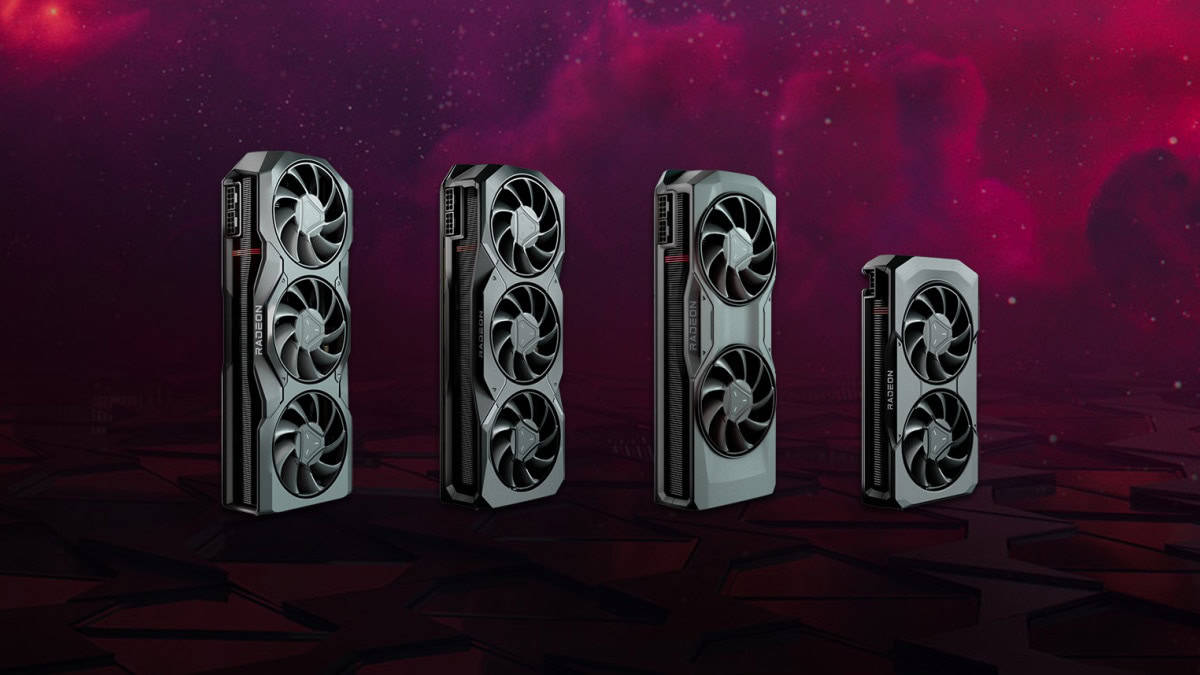AMD has set the stage for a significant hardware release in the coming months. The Radeon RX 9070 series GPUs will launch in March 2025, bringing new options for gamers and enthusiasts. This announcement ends speculation about an earlier release and provides a clear timeline for the next generation of AMD graphics cards.
The upcoming RX 9070 series will feature the new RDNA 4 architecture, promising improved performance and AI capabilities. This release could shake up the GPU market, offering fresh competition in the mid-range segment. Gamers and content creators alike are eagerly anticipating the potential improvements in graphics processing power and efficiency.
While details remain limited, the March launch window suggests AMD may embargo these new GPUs until early in the month of March 2025, so we will likely see reports and benchmarking roll out then. The company’s decision to target a Q1 2025 release indicates confidence in their product and readiness to compete with rival offerings.
AMD’s Upcoming RX 9070 Series: What We Know So Far
Release Date and Models
AMD has officially set the launch for its Radeon RX 9070 series for March 2025. This series will feature two main models: the RX 9070 XT and the RX 9070. This confirmation clears up prior confusion from early marketing materials that hinted at a January release. The delay, according to AMD, is to make sure the drivers are stable, FidelityFX Super Resolution 4 (FSR 4) is well supported, and there are enough cards available when they launch.
What to Expect from Performance
While specific performance numbers are not public yet, we can make some educated guesses. The RX 9070 series uses the RDNA 4 architecture. This new architecture is expected to bring improvements in performance per watt and overall processing power compared to the current RDNA 3 cards. It is reasonable to expect the RX 9070 XT to compete with NVIDIA’s high-end offerings, while the RX 9070 will likely target the upper mid-range market.
FidelityFX Super Resolution 4 (FSR 4)
AMD is putting a lot of emphasis on FSR 4. This is their answer to NVIDIA’s DLSS technology. FSR upscales lower-resolution images to higher resolutions, improving performance without a big loss in visual quality. FSR 4 is expected to bring even better image quality and performance gains than previous versions. AMD’s focus on FSR 4 integration shows they want to offer a smooth gaming experience even at higher resolutions.
Availability and Partner Cards
AMD has stated there will be a “wide assortment of cards” available globally from various manufacturers. This means we should see cards from companies like ASUS, MSI, Gigabyte, and Sapphire, each with their own custom designs and cooling solutions. This variety is good for consumers as it provides more choices in terms of price, features, and aesthetics.
Comparison Table: Current and Upcoming AMD GPUs (Estimated)
| GPU | Architecture | Target Market | Estimated Performance Level |
|---|---|---|---|
| RX 7900 XTX | RDNA 3 | High-End | Very High |
| RX 7900 XT | RDNA 3 | High-End | High |
| RX 7800 XT | RDNA 3 | Upper Mid-Range | Mid-High |
| RX 9070 XT | RDNA 4 | High-End | Likely Very High |
| RX 9070 | RDNA 4 | Upper Mid-Range | Likely High |
What This Means for Gamers
The RX 9070 series launch is good news for gamers. It offers more choices in the GPU market and pushes both AMD and NVIDIA to innovate and improve their products. The focus on driver stability and FSR 4 support also shows that AMD is listening to feedback and wants to provide a better user experience.
Looking Beyond the RX 9070 Series: The Future of RDNA
AMD’s commitment to RDNA architecture signals ongoing development and new generations of GPUs. We can anticipate even more powerful cards in the future, possibly including RX 9080 or RX 9090 models aimed at the extreme high-end. AMD may also release lower-end cards to serve different price points. Special cards for professional use or specific applications like artificial intelligence are also a possibility. Further improvements to FSR are likely, with a focus on better image quality and performance. AMD will likely integrate RDNA technology into other products like CPUs and APUs, making its technology work across its product line.
Key Takeaways
- AMD’s Radeon RX 9070 series GPUs will be available in March 2025
- The new cards will feature RDNA 4 architecture with enhanced AI capabilities
- This launch could significantly impact the mid-range GPU market for gamers and creators
Technical Specifications and Performance
The AMD Radeon RX 9070 series will launch in March 2025, featuring the RX 9070 XT and RX 9070 models based on the RDNA 4 architecture. This series promises improved performance, enhanced efficiency, and cutting-edge features aimed at gamers and professionals.
AMD is committed to driver stability, robust FSR 4 support, and ample stock availability at launch. The global release will include partner cards from various manufacturers, providing gamers with diverse options. The RX 9070 series is targeted at the high-end and upper mid-range GPU markets.
Architecture and Hardware Innovations
The RX 9070 series is built on AMD’s RDNA 4 architecture, featuring a 4nm manufacturing process. This allows for increased transistor density and improved power efficiency. The flagship Radeon RX 9070 XT is expected to have:
- 64 Compute Units
- 4096 Stream Processors
- 16GB GDDR6 memory
- 256-bit memory bus
- Boost clock speeds exceeding 2.9 GHz
These specifications represent a notable upgrade from the previous generation. The increased number of Compute Units and higher clock speeds should result in improved performance across various applications.
Comparative Analysis with Competitors
The RX 9070 series aims to compete directly with NVIDIA’s RTX 4070 lineup. Early projections suggest that the 9070 XT may offer:
- 10-15% higher frame rates in 1440p gaming
- Improved ray tracing performance
- Enhanced AI and machine learning capabilities
However, NVIDIA still holds an advantage in some areas:
- More mature ray tracing implementation
- Superior DLSS technology
Intel’s Arc GPUs remain a distant third in this performance tier, but continue to improve with driver updates.
Gaming and Professional Application Benchmarking
Preliminary benchmarks indicate strong performance for the RX 9070 series:
Gaming at 1440p:
- 120+ FPS in most AAA titles
- 144+ FPS in competitive esports games
Content Creation:
- 20% faster video encoding compared to previous gen
- Improved 3D rendering times in professional applications
Ray Tracing:
- 30% better performance in ray-traced scenes vs RX 7900 series
The RX 9070 series is set to launch in March, with pricing expected to be competitive. The RX 9070 XT may be priced around $599, while the standard RX 9070 could target a $499 price point.
Market Positioning and Consumer Considerations
AMD’s Radeon RX 9070 series aims to capture the mid-range GPU market with competitive pricing and performance. The new graphics cards target gamers and content creators seeking powerful yet affordable options.
Pricing Strategy and Availability
AMD plans to position the RX 9070 series competitively against NVIDIA’s RTX 4070 lineup. The company will likely price these cards to attract budget-conscious consumers who want high performance without breaking the bank.
Exact pricing details remain unconfirmed. Industry analysts expect the RX 9070 XT to fall in the $400-$500 range, with the standard RX 9070 priced slightly lower.
Availability is set for March 2025. AMD aims to ensure adequate stock at launch to avoid shortages and inflated prices seen with previous GPU releases.
Target Audience and Usage Scenarios
The RX 9070 series targets:
- Gamers seeking 1440p high refresh rate gaming
- Content creators requiring GPU acceleration
- Enthusiasts building mid-range PCs
These cards excel in:
- AAA gaming at high settings
- Esports titles at competitive framerates
- Video editing and 3D rendering
- AI and machine learning tasks
The inclusion of AMD’s FSR 4 technology aims to compete with NVIDIA’s DLSS, offering enhanced performance in supported games.
Futureproofing and Ecosystem Compatibility
The RX 9070 series incorporates several future-ready features:
- PCIe 5.0 support for increased bandwidth
- Improved ray tracing capabilities
- Enhanced AI performance for content creation
AMD’s RDNA 4 architecture promises better energy efficiency, potentially reducing power consumption and heat output compared to previous generations.
These cards will likely support AMD’s open-source technologies, ensuring compatibility with a wide range of systems and software. This approach may appeal to users who prefer flexibility in their hardware choices.







